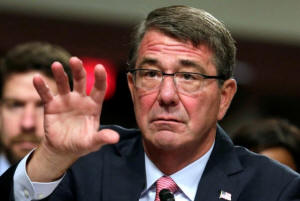|
Cost of modernizing U.S. nuclear weapons
to fall to next president
 Send a link to a friend
Send a link to a friend
 [September 27, 2016]
By Yeganeh Torbati [September 27, 2016]
By Yeganeh Torbati
MINOT AIR FORCE BASE, N.D. (Reuters) - In
this flat, windy expanse just south of the Canadian border, U.S. Air
Force pilots fly the same bombers their grandfathers flew, using
mid-20th century cables and pulleys.
Each spring, the airmen and airwomen must clear melting snow from the
steel and concrete doors of the silos that house 150 nuclear-tipped
ballistic missiles scattered across thousands of square miles of the
upper Great Plains.
The U.S. nuclear arsenal, patched, welded, and re-skinned countless
times, was built between 25 and 62 years ago when the United States
found itself locked in an arms race with a rival superpower, the Soviet
Union. Now, its future is an issue in the campaign for the Nov. 8
presidential election.
Democratic candidate Hillary Clinton has said she would call for a
nuclear posture review, last completed in 2010, as one of her first acts
upon taking office. Republican candidate Donald Trump has said he would
be open to reversing decades of U.S. policy and allowing allies such as
Japan and South Korea to acquire their own nuclear weapons to deter a
strike from North Korea, which carried out its fifth and largest nuclear
test this month.

On Monday, in his first visit to Minot Air Force Base in North Dakota as
U.S. Secretary of Defense, Ash Carter said America's nuclear deterrence
was the "bedrock" of its security, and the Pentagon's No. 1 priority.
"If we don't replace these systems, quite simply they will age even
more, and become unsafe, unreliable, and ineffective," Carter said,
speaking at a lectern in front of a B-52 bomber loaded with cruise
missiles.
"The fact is, most of our nuclear weapon delivery systems have already
been extended decades beyond their original expected service lives. So
it's not a choice between replacing these platforms or keeping them -
it's really a choice between replacing them or losing them," Carter
said.
Russia, he said, had built new nuclear weapons systems, raising
questions as to whether its leaders were cautious enough when it came to
atomic weapons. And North Korea presents a sustained threat, Carter
said.
Carter's speech coincides with a growing realization among defense
officials and experts that budget constraints almost certainly will
force the next president to decide whether and how quickly to proceed
with the Obama administration's plans to maintain and modernize the U.S.
nuclear arsenal.
CRUNCH TIME
The crunch comes in the next decade as American ballistic missile
submarines, bombers, and land-based missiles – the three legs of the
nuclear triad – reach the end of their useful lives.
The Congressional Budget Office estimates the total cost of nuclear
forces through 2024 at $348 billion, but that does not include some of
the costliest upgrades, scheduled for the latter half of the next
decade. Independent estimates have put the cost of maintaining and
modernizing the arsenal at about $1 trillion dollars over 30 years.
"There's a bipartisan commitment to doing that upgrade, so we have to
assume those funds will come through," Energy Secretary Ernest Moniz
told Reuters on Sept. 20. "But it will be a significant budget increase,
especially in the next decade."

The Energy Department shares responsibility with the Pentagon for the
nuclear arsenal, and some of its research and production facilities are
73 years old.
The next administration could abandon or delay some aspects of
modernization to cut costs. Or it could raise taxes, increase the budget
deficit, or cut domestic programs, all unpopular steps with American
voters.
The most vulnerable elements of the modernization plans are a long-range
standoff weapon, or LRSO – a nuclear-capable cruise missile launched
from an aircraft – and new land-based intercontinental ballistic
missiles (ICBMs).
Ten U.S. senators, including Elizabeth Warren of Massachusetts and
Bernie Sanders of Vermont, called on President Barack Obama in July to
cancel the LRSO, saying it "would provide an unnecessary capability that
could increase the risk of nuclear war."
[to top of second column] |

Defense Secretary Ash Carter testifies before a Senate Armed
Services Committee. REUTERS/Yuri Gripas

Some Pentagon officials and defense experts have said the cruise
missile would be a hedge against improved air defenses that are
difficult for even a stealthy bomber to penetrate.
A Clinton or Trump administration also could cut the number of
land-based ballistic missiles below the 400 currently planned or
delay a new missile by extending the life of the current Minuteman
IIIs, which each carry a warhead with an explosive yield of at least
300 kilotons, 20 times more powerful than the atomic bomb dropped on
Hiroshima, which killed an estimated 140,000 people.
The United States is one of five nuclear weapons states allowed to
keep a nuclear arsenal under the Nuclear Non-Proliferation Treaty.
The others are Russia, Britain, France and China.
The U.S. Air Force has estimated the cost of a new ground-based
system – including missiles, command-and-control systems and launch
control centers – to be more than $60 billion.
Some former U.S. officials, including former defense secretary
William Perry, have argued that land-based missiles are not
essential and should be phased out; proponents say they are more
important in the face of potential nuclear threats by Russia and
North Korea.
Much of the planned modernization is nearly locked in because of the
need for new weapons and because some of it is so far along, said
Evan Montgomery, a senior fellow at the Center for Strategic and
Budgetary Assessments, a Washington-based research group.

The B-21 long-range strike bomber and the replacement for the Navy's
14 Ohio-class ballistic missile submarines are "the two most
expensive items, and they're arguably the two safest in a lot of
ways," Montgomery said. The bomber can deliver both conventional and
nuclear weapons, and the submarine is considered a priority because
it would survive any first strike by an adversary.
The Navy plans to replace its Ohio-class submarines, first
commissioned in 1981 and armed with up to 24 Trident missiles with
multiple independently targeted warheads, with 12 boats costing
about $100 billion.
In his speech on Monday, Carter said that most people do not realize
that spending on the nuclear program is a small percentage of total
defense spending. At its peak, nuclear spending would make up about
five percent of the Pentagon's budget, which is now around $600
billion annually, defense experts said.
Still, the funding gap means that despite the Pentagon's massive
budget, the next president will face an unavoidable dilemma.
"There's no doubt in my mind that we're tens of billions of dollars
short in that time frame from what it takes to execute a global
strategy," said James Miller, a former undersecretary of defense for
policy in the Obama administration. "It's not a rounding error
anymore."
(Reporting by Yeganeh Torbati; additional reporting by Timothy
Gardner; Editing by John Walcott and Grant McCool)
[© 2016 Thomson Reuters. All rights
reserved.]
Copyright 2016 Reuters. All rights reserved. This material may not be published,
broadcast, rewritten or redistributed.
 |